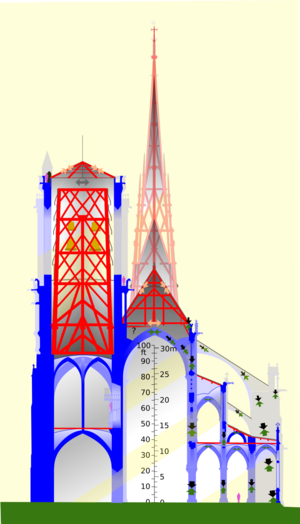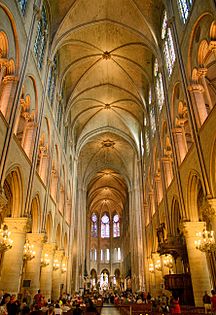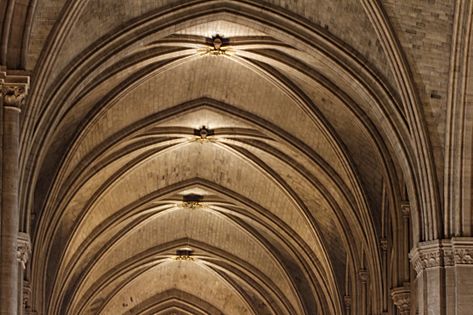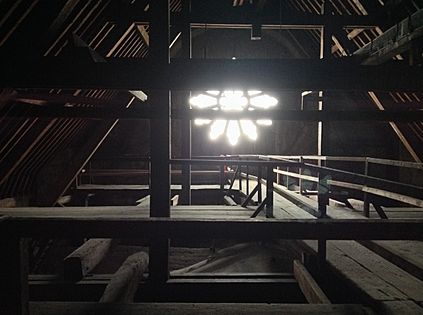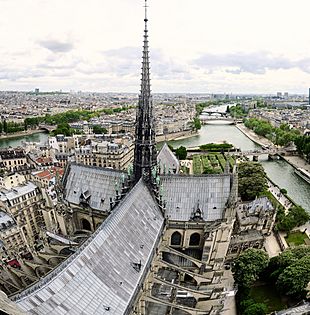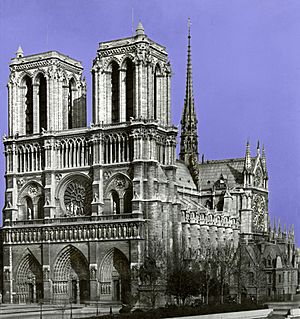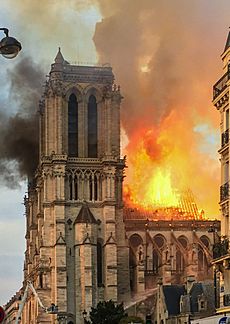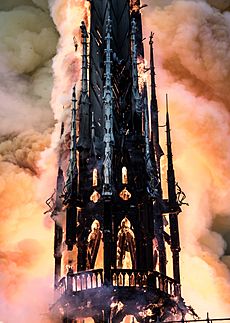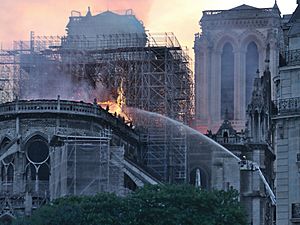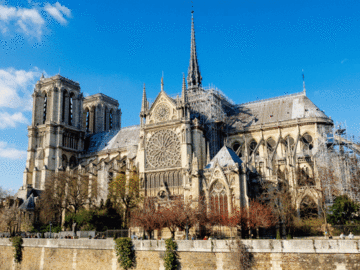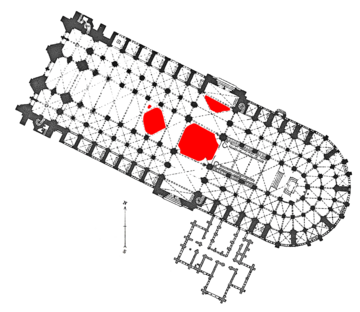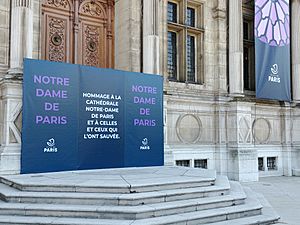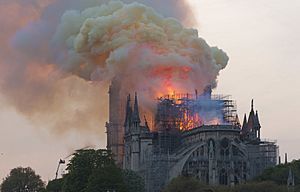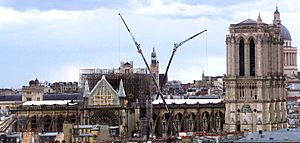Notre-Dame fire facts for kids
Quick facts for kids 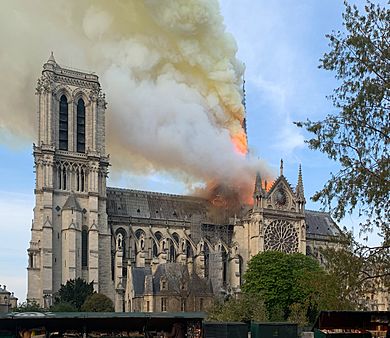
Notre-Dame de Paris as seen from Quai de Montebello, with the spire aflame
|
|
| Date | 15 April 2019 |
|---|---|
| Time | 18:20 CEST (16:20 UTC) |
| Duration | 15 hours |
| Venue | Notre-Dame Cathedral |
| Location | Paris |
| Cause | Accidental |
| Deaths | 0 |
| Non-fatal injuries | 3 |
| Property damage | Roof and spire destroyed; windows and vaulted ceilings damaged |
On April 15, 2019, a big fire broke out at Notre-Dame Cathedral in Paris, France. This famous church is very old, built in the Middle Ages. The fire started in the roof area just before 6:20 PM.
The fire burned for about 15 hours. It destroyed most of the roof and caused the cathedral's tall spire to fall. The upper walls were also badly damaged. Luckily, the stone ceiling inside the church helped protect many parts of the building. It kept the burning roof from falling directly onto the main floor.
Many valuable artworks and religious items were saved quickly. Some items got smoke damage, and a few outdoor artworks were harmed. But the main altar, two large organs, and three beautiful 13th-century rose windows were mostly unharmed. Three emergency workers were injured while fighting the fire.
The fire left behind some dust and lead, which needed to be cleaned up. Because of the fire, Notre-Dame could not hold a Christmas Mass in 2019. This was the first time since 1803 that a Christmas Mass was not held there.
Two days after the fire, French President Emmanuel Macron said the cathedral would be rebuilt in five years. Many people and groups have donated money to help. By September 2021, over €840 million had been given. The cathedral is planned to open again in December 2024. However, it might take 10 to 40 years for all the restoration work to be finished. Investigators think the fire might have started from a cigarette or a problem with the electrical system.
Contents
About Notre-Dame Cathedral
The Notre-Dame Cathedral is a famous Catholic church in Paris. Its name means "Our Lady of Paris." Building it started in the 12th century, a very long time ago! It is part of a UNESCO World Heritage Site.
The cathedral's walls and inner ceiling are made of strong stone. But its roof and tall spire were made of wood, mostly 13th-century oak. This wood was covered with lead to keep out water. The spire had been rebuilt several times, most recently in the 1800s.
Over many years, the stone of the cathedral had worn down from weather and pollution. The wood in the spire was also rotting because water got in through cracks in the lead covering. The roof timbers were very old and dry.
Before the fire, the cathedral needed a lot of repairs. The French government estimated it would cost €150 million. The church also asked for donations to raise €100 million. When the fire happened, the spire was already being repaired, and scaffolding was set up around it.
Fire safety was a big concern at the cathedral. The Paris Fire Brigade practiced regularly for emergencies there. A firefighter was even on duty at the cathedral every day. Fire wardens also checked the roof area three times a day.
- Parts of the Cathedral Important to the Fire
-
Timber in red, stone in blue. Left: tower, with framework and bells; centre (top to bottom, with spire shown behind): lead roof, timber roof trusses, stone ceiling vault, nave; right: exterior walls and flying buttresses. (Annotations)
-
Interior of nave showing rib vaulting; in walls are clerestory windows (top), arches to triforium (middle), and arches to side aisles (bottom).
-
Roof and spire. The Twelve Apostles and Four Evangelists statues at the spire's base had been removed for conservation days before the fire.
The Fire Starts
The fire began in the attic under the cathedral's roof at 6:18 PM. Two minutes later, the fire alarm went off. Guards helped people leave the cathedral. A guard was sent to check, but he went to the wrong place. He went to the attic of the nearby sacristy and found no fire.
About 15 minutes later, the mistake was found. But by the time guards climbed the 300 steps to the cathedral attic, the fire was already very big. The alarm system did not automatically call the fire department. Firefighters were called at 6:51 PM, after the guards returned. They arrived within ten minutes.
Police cleared out the Île de la Cité, which is the island where the cathedral stands. At first, white smoke rose from the roof. Then it turned black, and flames burst from the spire.
Fighting the Flames
More than 400 firefighters worked to put out the fire. Another hundred workers, police, and city staff helped move valuable items to safety. They formed a human chain to pass the precious objects.
Firefighters mostly fought the fire from inside the building. This was more dangerous for them but helped protect the cathedral. Spraying water from outside could have pushed flames and hot gases (up to 800°C) further inside. They used special water guns with lower pressure to avoid damaging the old building. Water was pumped from the Seine river nearby.
Firefighters did not use helicopters to drop water. Dropping water from high up could have damaged the building's structure. Also, hot stone can crack if it cools too quickly. Drones were used to see the fire and check temperatures. Robots were also used to see inside and direct water streams. Melting lead from the roof was a danger for the firefighters.
By 6:52 PM, smoke was clearly visible outside. Flames appeared ten minutes later, just as firefighters arrived. The cathedral's spire fell at 7:50 PM. This created a strong draft that slammed all the doors and sent a fireball through the attic. Firefighters then had to leave the attic.
Before the spire fell, the fire spread to the wooden frame inside the north tower. This frame held eight very large bells. If these bells had fallen, they could have destroyed the towers and the whole cathedral. By 8:30 PM, firefighters stopped trying to put out the roof fire. They focused on saving the towers, fighting from inside them. By 9:45 PM, the fire was under control.
Nearby apartment buildings were emptied because people worried they might collapse. But on April 19, the fire department said there was no risk. One firefighter and two police officers were injured.
What Was Damaged?
Most of the wooden roof and the spire were destroyed. About one-third of the roof remained. The burning roof and spire fell onto the stone ceiling below. Some parts of this ceiling collapsed, letting debris fall to the floor. But most of the ceiling stayed strong because of its special design. This greatly protected the inside of the cathedral and its treasures.
Notre-Dame held many priceless artworks and religious items. These included a crown of thorns believed to be worn by Jesus, a piece of the cross, and a tunic of St. Louis. It also had a famous pipe organ and a 14th-century statue called the Virgin of Paris.
Some artworks had been moved for renovations before the fire. Most of the church's sacred items were in the sacristy, which the fire did not reach. All the cathedral's religious relics survived. Emergency workers and staff formed a human chain to move many other valuable items to safety. Many items that were not moved also survived.
Some of the 19th-century stained-glass windows melted. But the three large rose windows from the 13th century were not damaged. A few church benches were destroyed. The stone arches inside were blackened by smoke. However, the church's main cross and altar survived, along with the statues around it.
Some paintings, which only had smoke damage, will be taken to the Louvre museum for cleaning. Statues, like those of the twelve Apostles at the base of the spire, had been removed for repairs. The rooster-shaped container on top of the spire was found damaged but whole. The three pipe organs were not badly damaged. The largest bell, called the bourdon, was safe. The church's treasury and large paintings were also saved.
Environmental Impact
The burned roof had over 400 tons of lead on it. When the roof burned, lead dust settled in some nearby areas. This raised lead levels on surfaces. People were advised to wet-clean surfaces and for children and pregnant women to get blood tests in the immediate area. There were some delays in testing and cleanup, which caused concern.
Lead levels in Paris streets are usually higher than indoor limits due to old uses of lead. After the fire, some areas had even higher levels. Officials worked to clean up and provide health advice. Rain can also spread the lead dust. Tests on honey from July 2019 showed higher lead levels downwind from Notre-Dame, confirming it came from the fire.
Reactions to the Fire
President Macron postponed a speech to visit Notre-Dame. He gave a short address there. Leaders from many countries and religious groups sent messages of sadness and support.
Through the night of the fire and the next day, people gathered along the Seine river. They held vigils, sang, and prayed. Some people saw deeper meaning in the fire, linking it to bigger ideas about society.
The Sunday after the fire, the Archbishop of Paris honored the firefighters. He gave them a book of scriptures that they had saved from the fire.
What Caused the Fire?
On April 16, the Paris prosecutor said there was no sign the fire was set on purpose. It was likely an accident.
This fire has been compared to other church fires, like the one at Windsor Castle in 1992. It made people think about how safe similar old buildings are during renovations. Repair work can increase the risk of fire. Police looked into whether the renovation work caused the fire.
Renovations can cause fires from sparks, electrical problems, or heat from welding. Normally, no electrical work is allowed in the roof space because of the high fire risk. The roof's wooden frame was very old and dry. After the fire, the fire safety architect admitted they had underestimated how fast a fire could spread. Experts knew that a fire in that roof would be very hard to stop.
Only one company, Europe Echafaudage, was working on the scaffolding the day of the fire. They said no welding was happening. The scaffolding had electricity for temporary lifts and lights. The roofers, Le Bras Frères, said their workers were not on site when the fire started. Time-lapse photos from their camera showed smoke first rising from the base of the spire.
On April 25, the building was safe enough for investigators to enter. They looked into theories about a problem with the electric bell-ringing system or cigarette butts found on the scaffolding. Le Bras Frères confirmed their workers had smoked, which was against rules. But they denied a cigarette butt could have started the fire. On June 26, the Paris prosecutor's office said there was no evidence of a crime.
The security guard watching the alarm system was new and working a double shift. Also, the alarm system was confusing, which caused the first delay in finding the fire. By April 2020, investigators believed the fire was caused by a cigarette or an electrical short circuit.
Rebuilding Notre-Dame
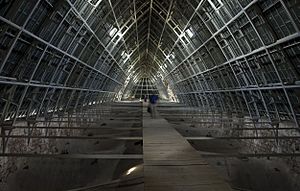
The night of the fire, President Macron promised to rebuild the cathedral. He started a worldwide fundraising effort. In France, cathedrals have been owned by the state since 1905, so they are not privately insured.
Experts estimated the damage would cost hundreds of millions of euros. While some art and construction companies had insurance, the overall cost was not expected to greatly affect the insurance industry. Some estimated the cost could be similar to the €7 billion renovation of the Palace of Westminster in London. This cost does not include damage to artworks owned by the cathedral, which usually are not insured.
Macron hoped the cathedral could be ready for the 2024 Summer Olympics in Paris. However, experts think the work could take 10 to 40 years. The new structure needs to look like the original, using wood and stone from the same areas. It also needs to be stronger to prevent future disasters.
There was talk about changing the cathedral's design during rebuilding. Some suggested using titanium and steel for the roof. Others wanted to rebuild it exactly as it was, with lead and wood. Another idea was to use modern materials that wouldn't be seen from the outside.
The French prime minister announced a competition for a new spire design. This caused some debate, especially about making exceptions to environmental and heritage rules. The French Senate wanted the roof to be rebuilt exactly as it was before the fire. But the National Assembly disagreed. Finally, a law was passed in July that allows for some flexibility in the design, while still respecting the cathedral's history. It left the final design of the spire undecided.
In April 2020, Germany offered to help restore some of the large stained-glass windows high up in the cathedral. They offered three expert workers and said they would pay the costs.
Also in April 2020, the French game company Ubisoft offered its research to help with the rebuilding. They had spent over 5,000 hours studying the cathedral to recreate it for their video game Assassin's Creed Unity.
By November 2020, all the tangled scaffolding around the spire area was removed. This was a big step, as it was a threat to the building.
In April 2022, President Macron visited the cathedral to see the progress. He spoke with the workers about their efforts. In spring 2022, eight workshops across France began cleaning and restoring the cathedral's stained-glass windows. A workshop from Cologne Cathedral in Germany also joined to restore four windows.
The cathedral is expected to reopen in December 2024.
Raising Money
By April 22, 2019, over €1 billion had been promised for the cathedral's rebuilding. More than €880 million of this was pledged in less than a day after President Macron's appeal. Many large companies and wealthy families made big donations.
Some of the biggest donations included:
- Arnault family & LVMH (€200 million)
- Bettencourt family & L'Oréal (€200 million)
- Pinault family & Artémis (€100 million)
- Total SA (€100 million)
- Paris city government (€50 million)
- BNP Paribas SA (€20 million)
- Decaux family & JCDecaux (€20 million)
- AXA SA (€10 million)
- Lily Safra (€10 million)
- Bouygues family (€10 million)
- De Lacharrière family & FIMALAC (€10 million)
- Île-de-France (€10 million)
- Société Générale (€10 million)
- BPCE (€10 million)
Many other people and groups also promised smaller amounts. A proposal to give big tax breaks for Notre-Dame donations caused some public debate and was later changed. Some donors said they would not ask for tax deductions.
By June 2019, only €80 million had actually been collected. Officials expected more money to come in as the work continued. By September 2021, over 320,000 donors had contributed more than €840 million.
The organization "Friends of Notre-Dame de Paris" regularly shares updates on the restoration.
See also
 In Spanish: Incendio de la catedral de Notre Dame de París para niños
In Spanish: Incendio de la catedral de Notre Dame de París para niños
- Construction and renovation fires
- 1984 York Minster fire
- List of building or structure fires
- List of destroyed heritage
- List of fires at major places of worship




